NAR reports home sale increases, though prices also continued to rise

Existing-home sales rose 5.1 percent in May up to a seasonally adjusted annual rate of 5.35 million, up from an upwardly revised 5.09 million in April, according to a National Association of Realtors report. Sales have increased year-over-year for eight consecutive months, and are 9.2 percent above a year ago. This was the highest pace of sales since Sept. 2009.
However, the price problem continues to balance the positivity. While total housing inventory rose 3.2 percent to 2.29 million existing homes available for sale, the median existing-home price for all housing types rose to $228,700, a 7.9 percent increase over May 2014. This marks the 39th month of consecutive year-over-year price gains. Unsold inventory supply dropped slightly to a 5.1-month supply, down from a 5.2-month supply in April.
One of the largest problems with higher prices is that they’re paired with low wage growth. Wages rose only eight cents from April to May, and are up just 2.3 percent from the previous year. This number, which already struggles to match inflation’s pace, also trails the rise in home prices, which creates challenges for home-buying.
First American Chief Economist Mark Fleming discussed the problems facing potential homeowners with the increased prices.
“Countering the financial benefit of price appreciation, though, are increased interest rates and a modest rise in unemployment, which reduce the market capacity for existing-home sales,” Fleming said. “The increasing cost of financing a mortgage makes homeownership unaffordable for some first-time homebuyers and increases the cost of moving for existing homeowners. Additionally, uncertainty about wage growth and job security reduces the desire to make big purchase decisions, like buying a home.”
First-time Homebuyers Growth Deceptive
A notable gain in May was the percentage share of first-time buyers, which rose to 32 percent, up from 30 percent in April. This matches the highest share since Sept. 2012, and is up from 27 percent a year ago. This marks the first real gain after months of consistency, and while such a gain is nothing to ignore, it may be too early to call the first-time homebuyer problem fixed just yet.
We reported earlier this month about lower down payment requirements, and how some argued they could potentially increase the number of first-time homebuyers in the market.
However, though down payments have been declining, first-time homebuyers have not exactly flocked to the market. The percent share of first-time buyers was at 29 percent in February, 30 percent in March and 30 percent in April, compared to 28 percent in Feb. 2014, 30 percent in March 2014 and 29 percent in April 2014, despite the low down payments of 2015. While something has encouraged first-time homebuyers, it will take time to pin down what exactly spurred the growth, and more importantly, if those gains will continue.